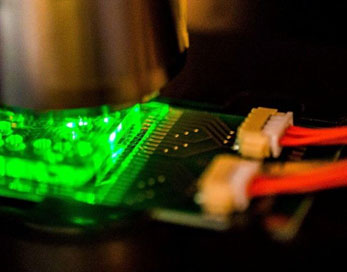Jürgen Popp and Ute Neugebauer received the 3rd prize of the Berthold Leibinger Innovation Award for Applied Laser Technology on September 21. The accidental discovery of penicillin in 1928 by Alexander Fleming marked the beginning of the triumphant advance of antibiotics. Many often fatal diseases and wound infections lost their terror. But there is a danger that humans will lose this weapon against bacteria. Mutations cause bacteria to develop resistance to current antibiotics. Developing new active substances, on the other hand, is expensive and very time-consuming. This is why there is talk of a serious antibiotics crisis worldwide.
 Photo: Berthold Leibinger Stiftung
Photo: Berthold Leibinger Stiftung
The accidental discovery of penicillin by Alexander Fleming in 1928 marked the beginning of the triumphant advance of antibiotics. Many often fatal diseases and wound infections lost their terror. But there is a danger that humans will lose this weapon against bacteria. Mutations cause bacteria to develop resistance to current antibiotics. Developing new active substances, on the other hand, is expensive and very time-consuming. Worldwide, therefore, there is talk of a serious antibiotics crisis.
A race against time
Especially in clinical use, in the treatment of serious infections such as sepsis, time is a crucial factor. Intensive care physicians far too often have to treat "blindly" with broad-spectrum antibiotics because they cannot initially determine the pathogen or any resistance that may be present. Early diagnosis is the basis for a reliable treatment decision, saves lives and reduces the risk of resistance developing. The light-based method developed by the research team led by Jena professors Ute Neugebauer and Jürgen Popp offers a fast and cost-effective alternative to the previously time-consuming microbiological pathogen diagnostics. Their lab-on-a-chip system is the result of close collaboration at the interface of photonics, medicine, microfluidics and systems integration at the Leibniz Institute for Photonic Technologies and the Center for Sepsis Control and Care at Jena University Hospital. Light-based diagnostics help assign the appropriate drug.
The combination of Raman spectroscopic diagnostics, microfluidic sample processing and a high degree of automation reduces the time from sample collection to result from the previous 72 to three and a half hours. Just a few drops of a patient sample, for example urine from a patient with cystitis, are sufficient for the rapid test. The researchers place the sample directly into the chip without any time-consuming preparation. No contact with the potentially infectious material is necessary during the automated analysis process. Electric fields trap the bacteria from the sample in a specific region of the chip, where they are identified based on their specific Raman spectrum and its comparison with databases. The Jena researchers then bring the pathogens into contact with various antibiotics in different concentrations and evaluate the spectral changes. The resulting data provide information on how high the concentration of the antibiotic must be to completely inhibit bacterial growth. This is an important diagnostic parameter that has a decisive influence on the success of the treatment.
On the way to practical application
The joint research has already resulted in the founding of the companies mibic and Biophotonics Diagnostics; they are building pathogen databases and developing devices for everyday medical use. Laboratories can already be equipped with the technology. The next generation of devices should then also be able to be used by doctors' surgeries and medical practitioners in the field.
(Press release Berthold Leibinger Stiftung, 21.09.2108 and image source: Berthold Leibinger Stiftung)

